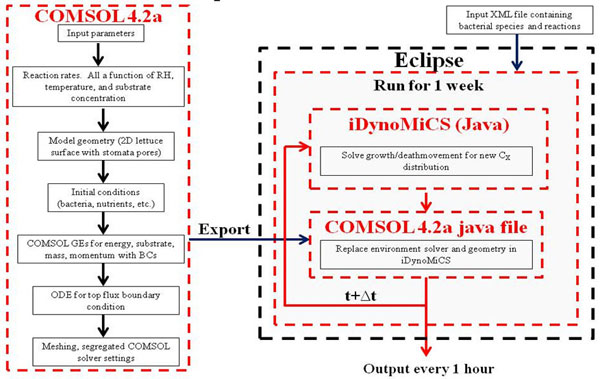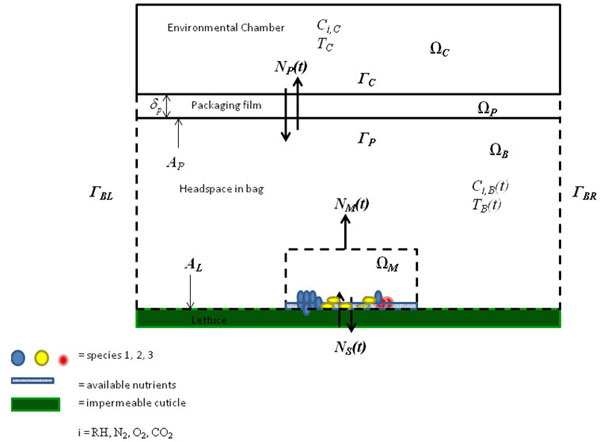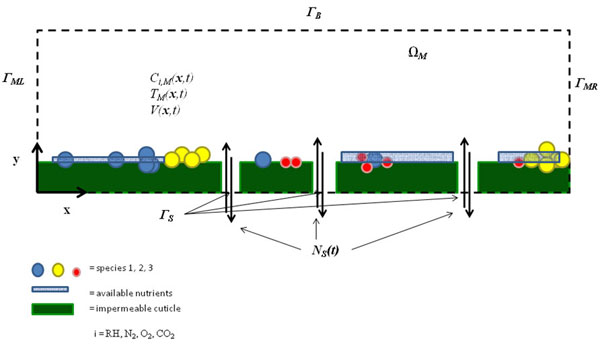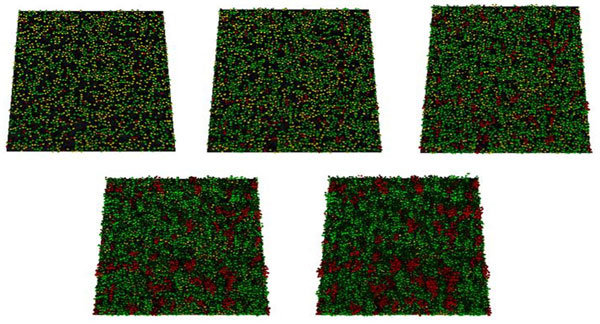28 Jan 2013
Our consumption of fresh produce rose by a quarter in the 20 years to 1999, so safety in fresh produce is ever more important. Our Seligman Fellow for 2012, Alex Warning from the US, has spent several months in the UK researching food safety modelling, and describes his visit below:
The Seligman APV Trust invites graduates or postgraduates or equivalents with a food engineering background from outside the UK to come to a UK university to conduct food-related research.
I am very grateful to the Seligman APV committee for giving me the opportunity to use this award to further my research. As a Seligman Fellow, I was a student visitor at the University of Reading, UK under Dr Keshavan Niranjan. I worked in the laboratory of Dr Rob Jackson at the University of Reading and performed my modelling with help from Dr Jan-Ulrich Kreft at the University of Birmingham, UK. I was in the UK from 19 May to 9 November 2012 conducting my research and visiting relevant industries and institutions.
Research Project
As the annual average weight of fresh produce consumed per person rose 25% in the 20 years from 1977-1979 to 1997-1999, fresh produce safety needs to increase as well.
Research in fresh produce safety has largely been empirical without a fundamental understanding. Models developed for food systems often rely on fitting an arbitrary equation to the experimental data, where model parameters have almost no physical significance. Models developed on one food, and for almost all foods, are not translatable to other food systems requiring the experiments and model to be recalculated again for a different food.
The lack of translation from one food to another is due to the variability in the topological structure of the food product, different available nutrients (specifically water, a carbon source, and a nitrogen source) to bacteria, different levels and species of native microflora present in a food and the way in which they interact with the foreign bacteria, and varying environmental factors such as temperature and shear stress.
Therefore, a comprehensive and fundamental understanding of bacterial growth, competition/cooperation, transport, and death on the surface of fresh produce will significantly increase the understanding of experimental results in fresh produce.
A theoretical model, that relies minimally on empirical relationships, will allow for a better understanding of experimental results where ultimately, by inputting the initial conditions of the system, the safety of a product can be determined and the necessary steps to improve safety can then be taken. Complete prevention of contamination is impossible, and a mitigation strategy must be used due to the amount of variables affecting contamination. Hence, only a fundamental understanding is the only practical solution as there is an infinite number of experiments that would need to be run.
Visits
During my time in the UK, I visited:
1. Centre for Systems Biology, University Birmingham Host: Dr Jan-Ulrich Kreft Dr Kreft and I worked to take his software, iDynoMiCS, and combine it with COMSOL while formulating my model. We worked on model simplifications and software coupling mainly as after meeting for a week, I could take the project the rest of the way.
2. SPX Flow Technology, Gatwick, UK Host: Dr Paul Skudder, Chief Technologist We discussed the current products and technology SPX is working on.
3. Department of Chemical Engineering and Biotechnology, Cambridge, UK Host: Dr Ian Wilson Dr Wilson gave me a tour of the department and labs along with a small tour of the campus. At the end I gave a presentation regarding my work. I had a chance to discuss different research fields with him and graduate students in the department.
Objectives
The objectives of this study were to:
1. Develop a 3D, multiscale, and mechanistic model that can predict bacterial growth, death, and transport on fresh produce
2. Qualitatively validate the results versus experimental data from a model leaf system and an actual leaf.
3. Study the effect of competing species, initial nutrient concentration, temperature, and chemical composition of the atmosphere
These parameters were chosen because they are well known, but it is not well understood how they influence pathogens. Native microflora can help or hurt foreign pathogens by competing for resources, or producing compounds to help foreign pathogens survive. Initial nutrient composition is a limiting factor in growth but also can influence direction of motility of bacteria to such physical features as stomata and wounds.
Temperature affects growth rate and the chemical composition of the atmosphere affects the microbial’s and plant’s rate of respiration, which is in turn based on stomata density. On top of these factors, the history of the bacteria (ie grown in cold/warm medium with or without acid) affects the bacteria’s response to the new environment on the plant. The ability to create a computational model will allow researchers to tie in all these factors when studying microbes. For this work, Escherichia coli, Pseudomonas fluorescens and Pantoea ananatis were chosen with E. coli as the human pathogen and the other two as the native microflora.
Problem Description and Schematic
A schematic is presented in Figs. 1 and 2 for the macroscale and microscale model that are coupled through the fluxes at the boundaries. The macroscale includes the environmental chamber and the head space in the bag which is then coupled to the microscale domain though a flux boundary.
The microscale model includes the leaf cuticle, the bacteria/biofilm, the boundary layer and a small region of the bulk above the lettuce. The microscale model assumes 2D heat, mass, momentum, and bacterial transport in the x and y-directions within in a periodic domain in the x-direction by taking a representative region of lettuce.
The macroscale model is assumed to be well mixed in the headspace and film such that there is no spatial gradient and only varies temporally. The cuticle is assumed impermeable to all species and temperature with no slip flow. The flux through the stomata is given by a relationship based on respiration rates of plants. The lateral boundaries are no flux to all species by symmetry. The environmental chamber’s concentration and temperature is a set boundary condition.
Figure 1: Macroscale model for simulation
Figure 2: Microscale model for simulation
Governing Equation
The governing equations are implemented in COMSOL and iDynoMiCS as shown in Fig 3. COMSOL simulates the environment, while iDynoMiCS simulates the bacteria. The macroscale balance equations are time-dependent mass balance equations, where the concentration in the head space changes with fluxes between the head space and the environmental chamber, and the head space and the microscale domains.

Figure 3: Simulation implementation
The microscale governing equations are broken up into the substrate transport and the biomass balance equations. The substrate transport is based upon a thin liquid film being present on the surface and is governed by Henry's law for gaseous components and transient diffusion equation for large molecules. Both equations have a reaction term for the loss and gain of components from the biomass. The assumption of the thin film being presented is from microscopic data that showed regardless of drying a fume hood bacteria existed not as dry cells but able to navigate a viscous water layer covering the surface of the leaf.
The biomass balance equations are based solely on mass conservation. As the cell consumes nutrients, the mass of each cell changes. Using density, the change in volume is calculated and once a cell reaches a threshold radius the cell splits. The rate of consumption for each cell is calculated using the Monod equation. The coupling between the empirical Monod equation and an individual growth kinetics for each cell give a semi-empirical model that is more realistic as each cell experiences a different local environment which for a population produces a greater mechanistic understanding of bacterial populations.
Preliminary Results
Figure 4. From the top left across and then down and across show day 0, 1,2 4, and 7 of a simulation of bacteria growing in competition. Green is P. fluorescens, yellow is P. ananatis, and red is E. coli.
Figure 4 shows one of the simulations for the three bacterial species competing for nutrients. The E. coli's faster growth rate allows it to overcome a low initial population such that it can out grow and colonise the leaf. Simulations with different nutrient concentrations and initial number of bacteria are being examined to determine if E. coli can be present initially but out competed and die out. The ability to simulate such phenomena is vital as the number of experiments would be unrealistic.
Future Research
Simulations for individual bacteria will be validated on leaf systems validating the model for single species and simulations will be conducted to determine experimental procedures that result in safe food. Additionally, particle tracing simulations will be utilised to calculate initial distributions along with detachment due to shear. The simulations on fresh produce will then be extended to meat and incorporating more complex food topologies.
Achievements and Benefits
The Seligman Fellowship provided me several benefits. As an American graduate student, we usually split our time between teaching, writing funding proposals, and research, and this fellowship let me focus solely on my research, so speeding up the time of my PhD.
In terms of my research, this fellowship granted me the opportunity to do experimental work that I would not have otherwise been able to accomplish in my lab group in the US, as my lab group is focused on mathematical modelling more than experimental work. The hands-on experience with what I am trying to simulate, increase my ability to make accurate assumptions in my simulations.
Additionally, being able to work with Dr Kreft afforded me a hands-on tutorial of the software his group has developed, enabling me to quickly incorporate it into my work rather than exchanging emails or blindly trying to understand the code.
As the Seligman Fellowship is for researchers outside the UK, this fellowship gave me an excellent opportunity to expand my understanding of research outside the US and improve my understanding of other cultures.
Overall, the Seligman Fellowship advanced my scientific and cultural awareness of the world which would not have otherwise been possible.
Acknowledgements
I would like to first and foremost thank the SCI Seligman APV Trust for selecting me for this fellowship along with Mr Graham Byars and Ms Charne Green for their constant help and support in making this fellowship possible and enjoyable.
I would like to thank Dr Keshavan Niranjan for his always reliable help in getting anything done in a timely fashion and his guidance in my research. I would like to thank Dr Robert Jackson for opening his lab for me to use, along with his graduate students Glyn Barrett, Amanda Livermore, and Sarah James for all the microbiology training. Thank you to Cornell University and my advisor Dr Ashim K Datta for letting me take this fellowship.
About Alex Warning
I am from the US and have lived in Illinois, Michigan, Florida, Virginia and now New York. I completed a bachelor's degree in mathematics and a bachelor's degree in chemical engineering with a food science minor in 2010 from Michigan State University.
During that time, I worked as a calculus tutor while working as a materials science intern for Kellogg's, a process engineer for Kellogg's, and a Tyvek pilot plant manager for DuPont.
Following my undergraduate degree and brief stints working in industry, I went directly to a PhD programme at Cornell University in Ithaca, NY USA.
My research is focused on multiscale, mechanistic computational modelling in food processing with an emphasis in food safety. My interest in maths and engineering with the complexity of food systems prompted this choice. I have published on vacuum-frying potato products, engineering approaches to improve food safety, improving food safety experimental design by using analytical simulations and process optimisation.
I am currently working on using lattice Boltzmann method to calculate transport properties in food, designing an easy-to-use food safety simulation for industry, and using individual based modelling to increase mechanistic understanding of food safety.
During my time as a Seligman Fellow at the University of Reading, I improved my assumptions in microbial modelling for food safety and worked with researchers at the University of Birmingham to bring individual based modelling to food safety as described above.
Besides research, I am also a teaching assistant for a biological and environmental engineering transport phenomena class and a teaching assistant for a biomedical modelling class. I enjoy working with students and seeing them develop models that improve the understanding and/or design of a biomedical problem.
Besides my studies, I am a marathon runner training for ultra marathons and regularly play ultimate frisbee in leagues around my university. I also enjoy consulting with students, researchers and businesses in using computational modelling to improve the design of their products or help them implement their models for their field of research. I have consulted on civil, acoustic and chemical engineering projects. The challenge of learning new physics and maths and applying that knowledge to a real world problem has been fun.



